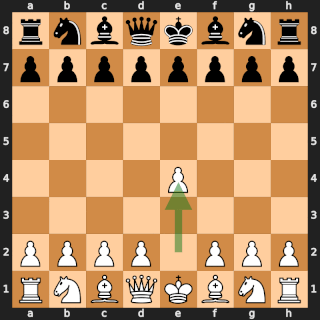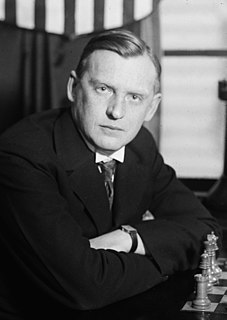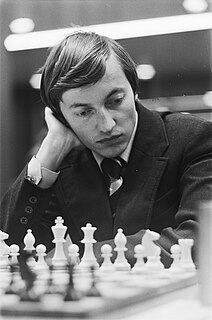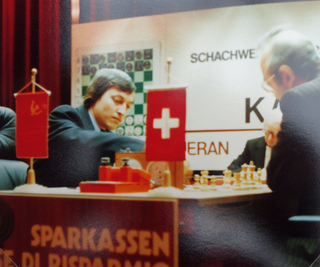A Babson task is a directmate chess problem with the following properties:
- White has only one key, or first move, that forces checkmate in the stipulated number of moves.
- Black's defences include the promotion of a certain pawn to a queen, rook, bishop, or knight.
- If Black promotes, then White must promote a pawn to the same piece to which Black promoted in order to complete the solution.
The Novotny is a device found in chess problems named after a problem from 1854 by Antonín Novotný, though the first example was composed by Henry Turton in 1851. A piece is sacrificed on a square where it could be taken by two different opposing pieces, but whichever makes the capture, it interferes with the other. It is essentially a Grimshaw brought about by a sacrifice on the critical square.
The Plachutta is a device found in chess problems wherein a piece is sacrificially positioned in blockade to deny coverage of multiple distant squares required by the opposition. For example, two of an opponent's bishops, queen, or rooks are defending locations through an intersection square, and an enemy unit moved into that square blocks disrupts coverage in such a way that, even if captured, the previous defensive situation cannot be restored.

The Opera Game was an 1858 chess game, played at an opera house in Paris. The American master Paul Morphy played against two strong amateurs: the German noble Karl II, Duke of Brunswick and the French aristocrat Comte Isouard de Vauvenargues. It was played as a consultation game, with Duke Karl and Count Isouard jointly deciding each move for the black pieces, while Morphy controlled the white pieces by himself. The game was played in a box while an opera was performed on stage. Morphy quickly checkmated his opponents following rapid development of material, involving a queen sacrifice.
X3D Fritz was a version of the Fritz chess program, which in November 2003 played a four-game human–computer chess match against world number one Grandmaster Garry Kasparov. The match was tied 2–2, with X3D Fritz winning game 2, Kasparov winning game 3 and drawing games 1 and 4.
In chess, a back-rank checkmate is a checkmate delivered by a rook or queen along a back rank in which the mated king is unable to move up the board because the king is blocked by friendly pieces on the second rank. A typical position is shown to the right.
In the game of chess, interference occurs when the line between an attacked piece and its defender is interrupted by sacrificially interposing a piece. It is a chess tactic which seldom arises, and is therefore often overlooked. Opportunities for interference are rare because the defended object must be more valuable than the sacrificed piece, and the interposition must itself present a threat. Huczek defines interference as a tactic involving blocking moves that obstruct lines of attack. This definition may be expanded by including blocking moves that disrupt lines of defense.
The Catalan is a chess opening where White adopts a combination of the Queen's Gambit and Réti Opening: White plays d4 and c4 and fianchettoes the white bishop on g2. A common opening sequence is 1.d4 Nf6 2.c4 e6 3.g3, although the opening can arise from various move orders. Encyclopaedia of Chess Openings (ECO) codes E01–E09 are for lines with 1.d4 Nf6 2.c4 e6 3.g3 d5 4.Bg2, and others are part of E00.
The Budapest Gambit is a chess opening that begins with the moves:
Anderssen's Opening is a chess opening defined by the opening move:

The World Chess Championship 2006 was a match between Classical World Chess Champion Vladimir Kramnik, and FIDE World Chess Champion Veselin Topalov. The title of World Chess Champion had been split for 13 years. This match, played between September 23 and October 13, 2006, in Elista, Kalmykia, Russia, was to reunite the two World Chess Champion titles and produce an undisputed World Champion.

In chess, a swindle is a ruse by which players in a losing position trick their opponent and thereby achieve a win or draw instead of the expected loss. It may also refer more generally to obtaining a win or draw from a clearly losing position. I. A. Horowitz and Fred Reinfeld distinguish among "traps", "pitfalls", and "swindles". In their terminology, a "trap" refers to a situation where players go wrong through their own efforts. In a "pitfall", the beneficiary of the pitfall plays an active role, creating a situation where a plausible move by the opponent will turn out badly. A "swindle" is a pitfall adopted by a player who has a clearly lost game. Horowitz and Reinfeld observe that swindles, "though ignored in virtually all chess books", "play an enormously important role in over-the-board chess, and decide the fate of countless games".

The World Chess Championship 1886 was the first official World Chess Championship match contested by Wilhelm Steinitz and Johannes Zukertort. The match took place in the United States, the first five games being played in New York City, the next four being played in St. Louis and the final eleven in New Orleans. The winner was the first player to achieve ten wins. Wilhelm Steinitz won the match 10–5, winning his tenth game in the twentieth game of the match.

The World Chess Championship 1889 was the second official World Chess Championship, and was between Wilhelm Steinitz and Mikhail Chigorin. It took place in Havana, Cuba. Steinitz successfully defended his world title, by being the first of the two players to reach 10½. He won the match 10½-6½.

The World Chess Championship 2012 was a chess match between the defending World Champion Viswanathan Anand of India and Boris Gelfand of Israel, winner of the 2011 Candidates Tournament. After sixteen games, including four rapid games, Anand retained his title. The match, held under the auspices of the World Chess Federation FIDE, took place between 10 and 30 May 2012 in the Engineering Building of the State Tretyakov Gallery, Moscow, Russia. The prize fund was US$2.55 million.

The 1935 World Chess Championship was played between challenger Max Euwe and title-holder Alexander Alekhine. It was played in various cities and towns in the Netherlands from October 3 to December 16. Euwe was the winner by overcoming a three-point deficit as late as the ninth game.

The 1978 World Chess Championship was played between Anatoly Karpov and Viktor Korchnoi in Baguio, Philippines from July 18 to October 18, 1978. Karpov won, thereby retaining the title.

The 1981 World Chess Championship was played between Anatoly Karpov and Viktor Korchnoi in Merano, Italy from October 1 to November 19, 1981. Karpov won with six wins against two, with 10 draws. The two players had already played against each other in the World Chess Championship match 1978 in the Philippines, when Karpov also won.

The World Chess Championship in 2018 was a match between the reigning world champion since 2013, Magnus Carlsen, and the challenger Fabiano Caruana to determine the World Chess Champion. The 12-game match, organised by FIDE and its commercial partner Agon, was played at The College in Holborn, London, between 9 and 28 November 2018. The games were broadcast on worldchess.com and by NRK.
Kasparov's immortal is a chess game played by Garry Kasparov as White against Veselin Topalov as Black at the Hoogovens Wijk aan Zee Chess Tournament 1999 chess tournament. This is one of Kasparov's most famous games; it is considered a masterpiece and Chess.com has listed it as the #1 chess game ever played.









